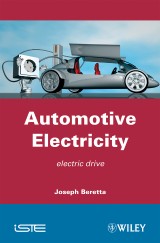Details

Automotive Electricity
Electric Drives1. Aufl.
|
140,99 € |
|
| Verlag: | Wiley |
| Format: | EPUB |
| Veröffentl.: | 04.03.2013 |
| ISBN/EAN: | 9781118617373 |
| Sprache: | englisch |
| Anzahl Seiten: | 304 |
DRM-geschütztes eBook, Sie benötigen z.B. Adobe Digital Editions und eine Adobe ID zum Lesen.
Beschreibungen
<p>Since the beginning of the century, electrical engineering technologies and applications have pervaded daily life and are present in the majority of everyday products, tools, and appliances. Increasingly these applications are becoming more prevalent in the automotive vehicle and products market. While change in this field has been relatively slow over the last ten last years, the pace of change is now beginning to accelerate and we are witnessing a wave driven by regulatory constraints and market laws which are sweeping away the last bastions of resistance. <p>This book discusses both the historical and scientific issues surrounding the application of electrical technology in the automotive drives field, as well as potential future developments, such as hybrid vehicles and fuel cells. In the current context of energy conservation, pollution prevention, and carbon control, this book will provide an important and timely examination of a potentially enormous new market.
<p>Preface ix</p> <p><b>Chapter 1. Introduction 1</b><br /> <i>Joseph BERETTA</i></p> <p>1.1. Automotive constraints 1</p> <p>1.2. Key figures from the automotive industry – data from the CCFA (association of French car manufacturers) 2</p> <p><b>Chapter 2. Basic Definitions 5</b><br /> <i>Joseph BERETTA</i></p> <p>2.1. Basic concepts 5</p> <p>2.1.1. Basics of automotive energy. 5</p> <p>2.1.2. Basics of automotive dynamics 7</p> <p>2.2. The different electric drive-train systems 10</p> <p>2.2.1. Basic definitions 10</p> <p>2.2.2. Definitions of drive-train systems 14</p> <p>2.2.3. Thermal-electric hybrid systems 19</p> <p>2.2.4. Complex hybrids 22</p> <p><b>Chapter 3. Electric-Powered Vehicles 27</b><br /> <i>Joseph BERETTA, Cyriacus BLEIJS, François BADIN and Thierry ALLEAU</i></p> <p>3.1. History 27</p> <p>3.2. Battery-powered electric vehicles 31</p> <p>3.2.1. Battery sizing 31</p> <p>3.2.2. Vehicle specifications 33</p> <p>3.2.3. Calculating the vehicle weights 34</p> <p>3.2.4. Application on a small vehicle 37</p> <p>3.3. Recharging systems for electric vehicles 40</p> <p>3.3.1. What is battery charging? 41</p> <p>3.3.2. The various types of chargers 41</p> <p>3.3.3. Recharging efficiency 49</p> <p>3.3.4. Recharging in complete safety 50</p> <p>3.4. Thermal/electric hybrid vehicles 53</p> <p>3.4.1. Assessment of traditional motorizations 53</p> <p>3.4.2. Implementation of hybrid transmissions 69</p> <p>3.4.3. Context of research concerning hybrid transmission 74</p> <p>3.4.4. Functionalities of hybrid architectures 82</p> <p>3.4.5. Evaluation of hybrid vehicles 110</p> <p>3.4.6. The first vehicles on the market 118</p> <p>3.5. Fuel-cell vehicles 144</p> <p>3.5.1. History, introduction 144</p> <p>3.5.2. Choosing the kind of fuel cell 145</p> <p>3.6. Bibliography 169</p> <p>3.7. Summary table of fuel-cell (PEM) vehicle prototypes (as of February 2005) 169</p> <p><b>Chapter 4. The Components of Electric-Powered Vehicles 173</b><br /> <i>Joseph BERETTA, Jean BONAL and Thierry ALLEAU</i></p> <p>4.1. Electric motors 175</p> <p>4.2. Electronic converters 180</p> <p>4.2.1. Characteristics of electric vehicles 180</p> <p>4.2.2. Components of electronic converters 181</p> <p>4.3.3. Generators – receivers – sources 182</p> <p>4.3.4. Rectifiers 185</p> <p>4.3.5. Choppers 186</p> <p>4.3.6. Inverters 202</p> <p>4.3. Batteries and static storage systems 207</p> <p>4.3.1. The different electrochemical couples for batteries 207</p> <p>4.3.2. Positioning of Ni-MH and Li-ion batteries for different applications 213</p> <p>4.3.3. Recycling processes 215</p> <p>4.4. The fuel cell and on-board fuel storage 217</p> <p>4.4.1. History of the fuel cell 217</p> <p>4.4.2. The different fuel-cell technologies 220</p> <p>4.4.3. The PEM fuel cell 223</p> <p>4.4.4. Technology and cost of fuel-cell components 235</p> <p>4.4.5. Peripherals of the fuel cell 241</p> <p>4.4.6. Numerical modeling of the fuel cell 246</p> <p>4.4.7. The fuel and its storage 249</p> <p>4.4.8. Conclusions. 264</p> <p>4.5. Bibliography 266</p> <p><b>Chapter 5. Prospects and Evolutions of Electric-Powered Vehicles: What Technologies by 2015? 269</b><br /> <i>Joseph BERETTA</i></p> <p>5.1. Mobility 269</p> <p>5.2. New technologies 274</p> <p>5.2.1. Electric motors 276</p> <p>5.2.2. Electronic power systems 278</p> <p>5.2.3. Electric energy sources 279</p> <p>5.3. New cars 282</p> <p>Automobile Glossary 291</p> <p><b>Appendices 313</b></p> <p>Appendix 1. European regulation emissions for light vehicles 313</p> <p>Appendix 2.a. Example of hybrid parallel transmission with flywheel storage 314</p> <p>Appendix 2.b. Example of hybrid parallel transmission with oleo-pneumatic storage 314</p> <p>Appendix 3. Example of function allocation 315</p> <p>Appendix 4. Toyota Prius engine 316</p> <p>List of authors 317</p> <p>Index 319</p>
<b>Joseph Beretta</b> is currently with the Division of Research and Automobile Innovation at PSA Peugeot Citroën, where he is responsible for the domain of electromechanical research, electrochemistry, electronics and systems.


















